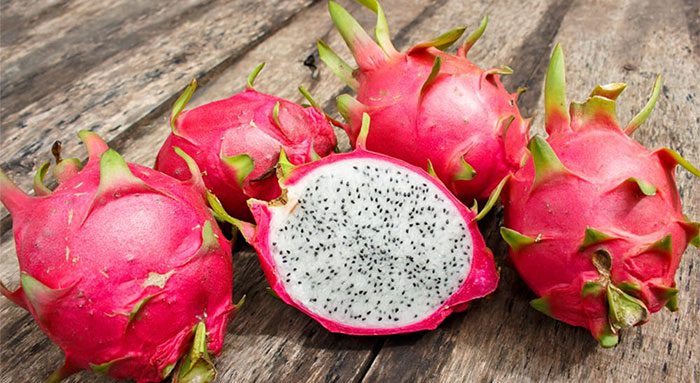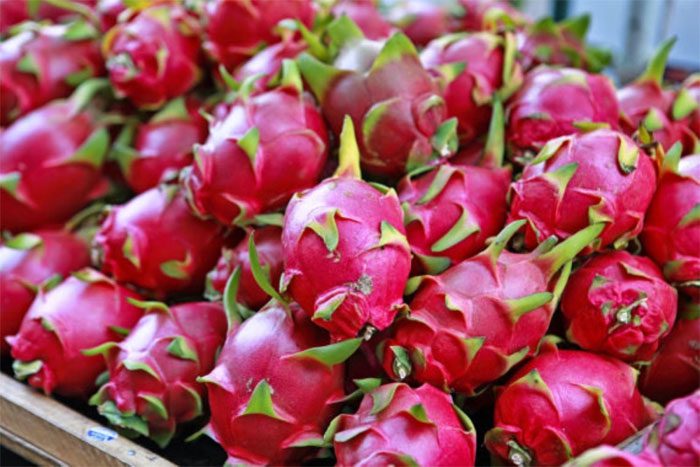In Vietnam, dragon fruit is an affordable fruit, but globally, it is considered a “superfruit” sought after for its numerous health benefits.
Dr. Huỳnh Tấn Vũ, Head of the Day Treatment Unit at the University of Medicine and Pharmacy – Campus 3, stated that dragon fruit comes from a species of cactus and is also known as Strawberry Pear, Pitaya, or Dragon Fruit. Dragon fruit is low in calories and rich in fiber and antioxidants.
According to the U.S. Department of Agriculture (USDA), one dragon fruit (approximately 100 g) contains 264 calories, 3.57 g of iron, 82.14 g of carbohydrates, 1.8 g of fiber, 82.14 g of sugar, 107 mg of calcium, 30 mg of sodium, 6.4 mg of vitamin C, and is free of cholesterol and fat.
With its subtly sweet flavor, dragon fruit is used to create various delicious drinks and dishes such as smoothies, juices, dragon fruit dessert soup, dragon fruit cakes, and dragon fruit jams.

Dragon fruit contains antioxidants betacyanin and betaxanthins that neutralize free radicals in the body.
According to Dr. Vũ, both red-fleshed and white-fleshed dragon fruit have high nutritional content that meets essential dietary needs. Notably, the antioxidants (polyphenols, carotenoids, vitamin C, etc.) in dragon fruit help prevent cancer, chronic diseases, and enhance immunity.
Regularly adding dragon fruit to meals can help prevent chronic diseases such as heart disease, cancer, diabetes, arthritis, and can also enhance skin beauty…
Here are the scientifically proven benefits of dragon fruit:
Rich in Antioxidants
According to a study published in the African Journal of Biotechnology, dragon fruit contains antioxidants like betacyanin and betaxanthins that neutralize free radicals in the body, preventing them from harming organs.
Additionally, the World Journal of Pharmacy and Pharmaceutical Sciences notes that the antioxidants in dragon fruit are beneficial in preventing inflammatory conditions in the body, such as gout and other forms of arthritis.
Blood Sugar Control
A study in PLOS ONE highlights the positive impact of consuming dragon fruit on blood sugar control in diabetes patients. This is due to the nutrients in this fruit promoting the growth of insulin-producing pancreatic cells.

Both red-fleshed and white-fleshed dragon fruit have high nutritional content.
Rich in Vitamins and Minerals
The World Journal of Pharmacy and Pharmaceutical Sciences indicates that dragon fruit contains magnesium, phosphorus, potassium, vitamin A, vitamin C, zinc, and small amounts of calcium and copper.
Prebiotic Properties
Dragon fruit acts as a prebiotic (soluble fiber that is not digested in the small intestine), helping to enhance and nourish gut bacteria, according to the Electronic Journal of Biotechnology.
Dragon fruit also contains oligosaccharides, a type of carbohydrate that stimulates the growth of beneficial bacteria for the stomach and intestines, supporting many aspects of human health.
Contains Healthy Fatty Acids
The seeds of dragon fruit provide significant nutritional value due to their high content of fatty acids, including omega-3 and omega-9.
Experts recommend eating the seeds of dragon fruit. Additionally, the skin of dragon fruit contains many antioxidants that have anti-inflammatory effects, although it has a bitter taste, which can be eaten separately or used in salads.
However, it is essential to note that while dragon fruit is a healthy food, it should be consumed in moderation and combined with other fruits.
Reduces Disease Risk and Boosts Immunity
Dragon fruit contains bioactive compounds that can provide health benefits far beyond basic nutritional value. Particularly, dragon fruit contains vitamins C and A, which help with antioxidant activity. Additionally, it contains potassium. These compounds may help prevent diseases related to inflammation and oxidation, including:
- Diabetes
- Cardiovascular diseases
- Cancer
- Dyslipidemia (high cholesterol)
Metabolic syndrome (a combination of conditions that increase the risk of diabetes, stroke, and heart disease).
High in Fiber
According to the U.S. Department of Agriculture, a 100-gram serving of dragon fruit contains over 3 grams of fiber. The U.S. Food and Drug Administration (FDA) recommends a fiber intake of 28 grams per day, based on a 2,000-calorie diet and depending on an individual’s gender.
Hydration Source
Nutrition expert Kim Shapira from Los Angeles, USA, states that besides being a source of fiber, dragon fruit is also a good source of hydration, both of which support digestion and prevent constipation. However, dragon fruit also contains a significant amount of natural sugars, which can lead to bloating, gas, and diarrhea if consumed excessively. Shapira notes that individual reactions to dragon fruit and other fruits may vary.
Shapira advises starting with half a dragon fruit and waiting at least 15 minutes before consuming the rest. Shapira explains: “In general, eating in moderation and observing individual tolerance levels can help manage any discomfort.”
“I always recommend starting with half your usual portion and waiting to see how your body feels,” the expert said.



















































